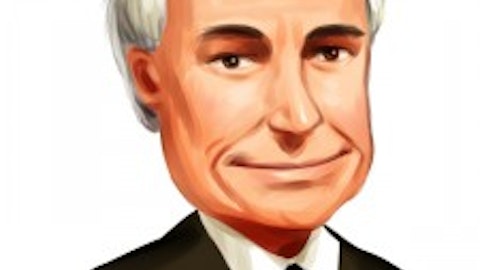Those things improve our margins on the unit economics of any transaction. And they also are going to start to improve our marketing allowables, which means that we can go out in our paid marketing and buy more, buy better because we have better matching behind it. The sources of demand beyond paid marketing is really a combination of direct and SEO, and that’s going to come from improvements in the product experience. We know what drives homeowner satisfaction and homeowner repeat rate, and that’s better matching with service professionals and a better chance of getting a job done well. And so we are starting to drive those underlying metrics. We shared some of those stats in the letter. And we need that now to show up over time in direct and SEO.
It’s not going to be sort of an automatic where it just sort of flips on a switch. But it is something that over time with a better experience, you start to see those users coming in, coming in more often, coming in our free channels and referring their friends and family. That’s what happens with a better product experience. That does take time for people to realize it. And the other thing I’ll say is, that is what we saw happen in Europe. Europe has grown 20% the last couple of quarters. Europe is — I don’t know that we’ll hold on to 20% exactly, but double-digit growth is very real in Europe, has been real for a while and that’s a product of, I think, a better customer experience. Then the other thing just tactically is that the comps do get easier starting in Q2.
Brian Fitzgerald: Got it. Thanks, Joey. Appreciate it.
Joey Levin: Thanks, Brian. Drew, next question.
Operator: The next question comes from Jason Helfstein with Oppenheimer. Please go ahead.
Jason Helfstein: Hey. Thanks, guys. Good morning. Two questions on Dotdash Meredith, and then a quick housekeeping question. So what percent of ads or coverage does D/Cipher cover? And is there still risk of DDM’s fall post cookie deprecation? And then how do you think potentially about offsetting that with like a higher mix of performance inventory. So on D/Cipher, and then how are you thinking about the impact of the Amazon retail media partnership? And then, thoughts about expanding that to other DSPs and retail partners in ’24? And then I’ve got a housekeeping question after that.
Joey Levin: Sure, I’ll start. A lot of those questions are related. So, first we have D/Cipher in about 30% of our direct ad campaigns since we launched it less than a year ago. And I think that’s like 150 clients and the folks who are buying it are, as far as we can tell, very happy so far. No sign that people won’t be repeating on that. And then, when we’ve done case studies and we’ve done a couple, one with a large well known beauty brand. We did a case study with Amazon and in both cases saw a meaningful lift relative to cookie based targeting. So, we have a lot of confidence in D/Cipher’s ability to deliver for our customers. One of the things that will drive D/Cipher adoption is plugging into the pipes and the purchase path of DSPs, Demand Side Platforms, so that advertisers can access D/Cipher’s targeting easier or access it in areas where they’re already organizing their money and spending their money.
So, Amazon is the first example of that but we hope and expect that there will be many more beyond that. We’re obviously targeting the biggest ones first. Amazon is happening already. We’re working on something with Google and then, we’ll look to really integrate with every ad agency. And this is a thing that’s a win-win. It’s a win for the advertiser on performance. It’s a win for the partner where their data combined with our data delivers better, more spend. And certainly, it’s a win for us. If we can build into those pipes, which I think is totally doable, then we’ve got big opportunities for growth from here.
Jason Helfstein: And then just [Multiple Speakers] for Chris, the search and emerging and other were both weaker as far as I think the ’24 outlook versus the street. I guess with search, is this the new baseline for search? Just any color and then are there any one-time factors you want to call out why emerging and other was weaker than the street as well? Thanks.
Christopher Halpin: Yeah. Thank you, Jason. On search, the business definitely experienced a tougher market environment at the end of last year. You can see that in producing $7.5 million of adjusted EBITDA in the fourth quarter. It’s continued in the first quarter of this year, but we believe we’ve reached the baseline where we are and it should grow from here. That business has always done a great job of finding new areas in digital advertising to create value and create profit streams, that’s our goal for ’24. But hitting a baseline in profitability recently is what drives the $20 million to $40 million of adjusted EBITDA guidance. And that’s really just a reflection of the software environment for that business. On emerging and other, it’s a different story.
Last year, that business in ’23 generated $41.8 million of adjusted EBITDA. We disclosed a month ago that we’d signed a definitive agreement to sell our Mosaic subsidiary for $160 million in cash. That is expected to close very shortly — that transaction. Last year, and this is going to be in our disclosure, Mosaic generated about $37 million of revenue per quarter and averaged about $5 million of EBITDA. So think of it as $20 million of the $41.8 million of EBITDA is being sold, closing this month. Additionally, and this is in the guidance section, in Joey’s letter, we disclosed that in Q1 of this year, we expect to incur about $20 million of transaction expenses associated with that sale. That’s obviously non-recurring but will hit our definition of adjusted EBITDA in the first quarter and for the year.
So the emerging another guidance of zero to 20, half of that is non-recurring is brought down or it’s impacted by $40 million related to Mosaic. Half of that is non-recurring transaction expenses, and then half of that is run rate profitability that we sold for $160 million. So on an ongoing basis, I’d think of it as a $20 million to $40 million adjusted EBITDA segment. And the bulk of that would be care. Does that help? Jason?
Jason Helfstein: Yeah. Thank you very much.
Christopher Halpin: Okay. Thank you. Drew, next question.
Operator: The next question comes from Justin Patterson with KeyBank. Please go ahead.
Justin Patterson: All right. Thank you very much and good morning. Just two on Angi. You’ve kind of alluded to it a little bit so far, but would love to hear just what the top two or three priorities are for the business in 2024 to just keep executing on the foundation that you’ve built. And then just around international, you’ve mentioned taking some of the learnings from abroad and bringing it domestically into the Angi product. Could you elaborate a little more just what that means and how long that could potentially play out. Thank you.
Joey Levin: Yeah. So I’d say, driving free and repeat traffic through better user experiences, obviously that has big impacts on our business on our P&L, and it’s something that everybody in the Angi organization is thinking about. Second, and again, I’m — broken record on this, but we’ll keep going the health of the active SP network. That’s the retention gains we’ve seen holding those, growing those. That’s making sure pros are active and spending more and getting wins for that spend. That’s better targeting within the sales to reach our SP network. And you can see that we’ve been delivering that through better — through smaller sales force better targeted. But again, that all speaks to the health of the active SP network and the other one within, again, that same framework is starting to drive online, self-enroll for SP.
And probably the third would be unit economics, which is certainly partially number one and number two in terms of demand and supply, but it’s also driving things like conversion. We’ve had some big wins recently on conversion, but we still, I think, have a long way to go in terms of upside on driving conversion. We went through a period where conversion across most of our channels leaked a little bit and I think we can get a lot of that back. And so we’re very focused on driving conversion in ways that are win-win for users in our platform. And when that comes through, that moves the unit economics. So those are the big three. In terms of international, one is, well, first you saw Jeff Kipp, who was running the international business, who did a great job getting all of Europe onto a common platform and winning user experience.
Now he’s in the U.S. and some others from his team are now also helping out in the U.S. We brought the head of performance marketing in Europe, is now running performance marketing in the U.S. And the product and marketing leadership from Europe and the U.S are now much more closely intertwined and interacting. The other thing and this has been a theme for us for a while is the — and maybe it was easier to do this in Europe quietly than it is sort of in the U.S. with the public disclosure. But we did a lot to optimize user experience in Europe over short-term monetization for long term benefit. And that took a while to come through, but it has delivered in a meaningful way. And those trade-offs are trade-offs that we’ve been making in the U.S. and we expect to continue making in the U.S. And then the last one is, and this is very, very early for us, but the European business is almost entirely online self-enroll as opposed to a — from sales force and Europe is almost entirely online self-enroll, and U.S. is basically the inverse.
So we’re working on a lot of the learnings there to see how we can drive more online self-enroll in the U.S. and rely less on phone sales and really focus the phone sales on the opportunities that warrant it.
Christopher Halpin: Thank you, operator. Next question.
Operator: The next question comes from Dan Kurnos with The Benchmark Company. Please go ahead.
Dan Kurnos: Great. Thanks. Good morning. Joey, just quick follow-ups on Angi. You’ve been talking about it a lot this morning. I guess just how do you balance the consumer and the user and SP experience if you start going back towards showing multiple SPs per service request? And to follow up from Brian’s question, just are there any verticals where you’ve started to make a change or you’re starting to see a return to SR growth? Just help us think about how you’re attacking that a little bit more. And then, Chris, just on Dotdash on the margins, appreciate the color for the year. You’ve taken a lot of cost out of that business already. So I get sort of the cadence for ’24. But what are we waiting for? Is it a revenue level like you talked about in the past, or do we need to just see premium continue to stay strong this year to kind of get that real sort of vertical inflection that I think we’re still waiting for on Dotdash margins? Thanks.




